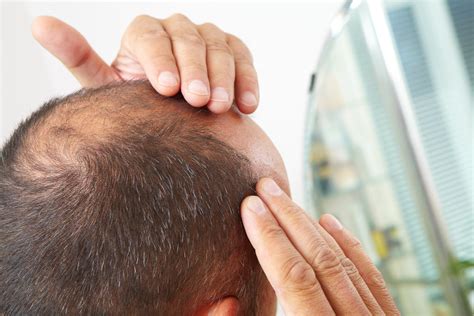The Science Behind Balding
Male-pattern baldness is a common condition that affects millions of men worldwide. It is caused by a combination of genetic and hormonal factors. The hormone dihydrotestosterone (DHT) is a major player in balding. DHT binds to receptors on hair follicles, causing them to shrink and produce thinner, weaker hair. Over time, the hair follicles may stop producing hair altogether, leading to baldness.

The Role of Shaving
Some people believe that shaving their hair can help to fight balding. The theory is that shaving removes the weak, thin hair, allowing room for new, stronger hair to grow. However, there is no scientific evidence to support this claim. In fact, shaving may actually damage hair follicles and make balding worse.
Potential Benefits of Shaving
While shaving does not fight balding, it may have some other benefits. For example, shaving can help to:
- Improve the appearance of the scalp. Shaving can remove dead skin cells and other debris from the scalp, making it look smoother and healthier.
- Reduce itching and irritation. Shaving can help to remove dead skin cells and other irritants from the scalp, reducing itching and irritation.
- Make it easier to apply topical treatments. Shaving can make it easier to apply topical treatments to the scalp, such as minoxidil or finasteride.
Potential Risks of Shaving
While shaving may have some benefits, it is also important to be aware of the potential risks. Shaving can:
- Damage hair follicles. Shaving can damage hair follicles, leading to permanent hair loss.
- Cause ingrown hairs. Shaving can cause ingrown hairs, which can be painful and unsightly.
- Spread infection. Shaving can spread infection if the skin is not properly cleaned and disinfected.
Alternatives to Shaving
If you are interested in treating balding, there are a number of other options available to you. These include:
- Minoxidil. Minoxidil is a topical medication that is applied to the scalp. It can help to slow down hair loss and promote hair growth.
- Finasteride. Finasteride is an oral medication that is used to treat balding. It works by blocking the production of DHT, the hormone that causes balding.
- Hair transplantation. Hair transplantation is a surgical procedure that involves transplanting hair follicles from one area of the scalp to another. This can help to restore hair growth in areas that have been affected by balding.
Conclusion
Shaving does not fight balding. In fact, it may actually damage hair follicles and make balding worse. If you are interested in treating balding, there are a number of other options available to you. You should talk to your doctor about the best option for you.
Informative Tables
Table 1: Male-Pattern Baldness Statistics
| Statistic | Source |
|---|---|
| 50% of men will experience male-pattern baldness by age 50 | National Institute of Health |
| 80% of men will experience some degree of hair loss by age 70 | American Academy of Dermatology |
| Male-pattern baldness is the most common type of hair loss in men | National Institutes of Health |
Table 2: Potential Benefits of Shaving
| Benefit | Explanation |
|---|---|
| Improves the appearance of the scalp | Removes dead skin cells and debris, making the scalp look smoother and healthier |
| Reduces itching and irritation | Removes dead skin cells and other irritants from the scalp |
| Makes it easier to apply topical treatments | Allows topical treatments to penetrate the scalp more easily |
Table 3: Potential Risks of Shaving
| Risk | Explanation |
|---|---|
| Damage hair follicles | Shaving can damage hair follicles, leading to permanent hair loss |
| Cause ingrown hairs | Shaving can cause ingrown hairs, which can be painful and unsightly |
| Spread infection | Shaving can spread infection if the skin is not properly cleaned and disinfected |
Table 4: Alternative Treatments for Balding
| Treatment | How it Works |
|---|---|
| Minoxidil | Topical medication that slows down hair loss and promotes hair growth |
| Finasteride | Oral medication that blocks the production of DHT, the hormone that causes balding |
| Hair transplantation | Surgical procedure that involves transplanting hair follicles from one area of the scalp to another |
